
January 2024
SurfLab researchers, together with an international team of collaborators, have published a paper in Journal of Physical Chemistry entitled “Umbrella-Like Helical Structure of Alpha-Synuclein at the Air-Water Interface Observed with Experimental and Theoretical Sum Frequency Generation Spectroscopy”.
In the paper, the researchers derive the structure of α-synuclein at the air-water interface by combining molecular dynamics with surface specific vibrational spectroscopy. Results show that the structure resembles an umbrella, which could help explain the α-synuclein aggregation associated with Parkinson's Disease.
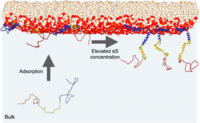
September 2023
SurfLab researchers, together with the Biomodelling group and Daniel E. Otzen from iNANO, have published a paper in Nature Communications entitled “Elevated concentrations cause upright alpha-synuclein conformation at lipid interfaces”. In the paper, the researchers show that the structure of α-synuclein changes conformation and promotes protein aggregation when the concentration exceeds normal physiological levels at a lipid membrane. α-synuclein aggregation in the human brain is associated with the development of neurodegenerative diseases such as Parkinson's Disease.
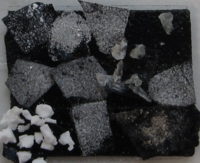
July 2023
SurfLab researchers, together with collaborators from the NSLS-II from Brookhaven National Laboratory have published a paper in Journal of Electron Spectroscopy and Related Phenomena entitled “A library of calcium mineral reference spectra recorded by parallel imaging using NEXAFS spectromicroscopy”. In the paper, the researchers created a calcium mineral array relevant for studying biomineralization in nature.
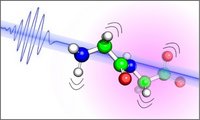
May 2023
SurfLab researchers augmented by Frank Jensen have published a paper in Journal of the Chemical Society of America entitled “Peptide bond of aqueous di-peptides is resilient to deep UV radiation”.
The paper shows that the vast majority of the excited di-peptides withstand the deep ultraviolet excitation. In those relatively few cases, where excitation leads to dissociation, the measurements show that deep ultraviolet irradiation breaks the Ca-C bond rather than the peptide bond. The peptide bond is thereby left intact and the decarboxylated di-peptide moiety is open to subsequent reactions.

May 2023
SurfLab researchers augmented by Frank Jensen have published a paper in Journal of the Chemical Society of America entitled “The primary photolysis of aqueous di-carbonate”.
The paper shows that when di-carbonate (CO32-) is excited at 200 nm, 82 +/- 5% of the excited di-anions either detach an electron or dissociate. The electron detachment takes place from the excited state in t < 1 ps and forms ground state CO3- and e(aq)-. Dissociation occurs from both the electronic ground and excited states of CO32-. Dissociation from the CO32- excited state is assisted by water molecules and forms CO2-, OH and OH-.
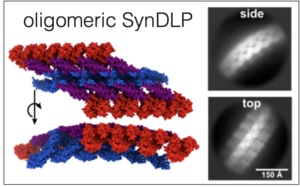
April 2023
Tobias Weidner has co-authored an article about bacterial dynamin-like proteins in Nature Communications.
The work, entitled “SynDLP is a dynamin-like protein of Synechocystis sp. PCC 6803 with eukaryotic features” has been a collaboration with several research groups including the University of Mainz and the Forschungszentrum Jülich.
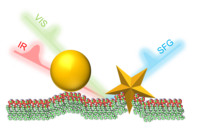
November 2022 - Article in Biointerphases
In collaboration with researchers at Oregon State University, SurfLab has published a paper using sum frequency generation vibrational spectroscopy to investigate shape-dependence of gold nanoparticles interacting with model cellular membranes. This study highlights the importance of mechanistic evaluations of nanomaterial technology.
Shape-dependent gold nanoparticle interactions with a model cell membrane
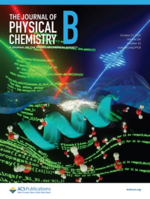
November 2022 - Article in Journal of Physical Chemistry B
SurfLab researchers in collaboration with Frank Jensen (AU) and Yuki Nagata (MPI-P) publish a new theoretical framework for simulating sum frequency spectra in Journal of Physical Chemistry B. The framework allows simulation of protein SFG using velocity-velocity time correlation functions based directly on classical MD simulations.

November 2022 - Article in the Journal of Physical Chemistry Letters
SurfLab researchers published a new technique for looking at proteins on the surface of emulsions using sum frequency generation vibrational spectroscopy in the Journal of Physical Chemistry Letters. This technique allows us, for the first time, to determine the structure and orientation of proteins at emulsion and nanoparticle interfaces.
Peptide Orientation at Emulsion Nanointerfaces Dramatically Different from Flat Surfaces
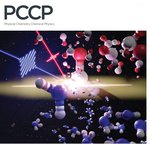
October 2022 - Article on the cover of PCCP
An article by Jan Thøgersen, Tobias Weidner and Frank Jensen about the photodissociation of formamide has been highlighted on the cover of PCCP.
The process described in the paper is likely relevant for origin-of-life chemistry.
The primary photo-dissociation dynamics of aqueous formamide and dimethylformamide
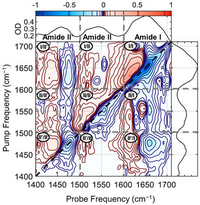
September 2022 - Paper in Molecules
In collaboration with researchers at the universities of Amsterdam and Sheffield, Surflab researchers have published a paper exploring 2D infrared spectroscopy of Bombyx mori native silk films. For the first time we could definitely identify the vibrational signatures inside the congested amide II zone.
”Broadband Multidimensional Spectroscopy Identifies the Amide II Vibrations in Silkworm Films”
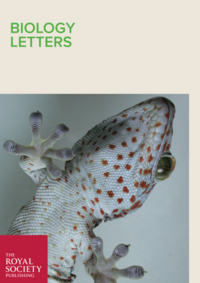
July 2022
Mette H. Rasmussen and Tobias Weidner have published in Biological Letters together with their collaborators from Kiel University, Oregano State University and Material Measurement Laboratory. The paper entitled “Evidence that gecko setae are coated with an ordered nanometre-thin lipid film”. Here, the orientation of the lipids residing on the adhesion toe pad of the Gekko gecko is investigated.

July 2022 - Paper in Journal of Physical Chemistry Letters
Surflab researchers published a new method of looking at proteins on the surface of emulsions using 2D infrared spectroscopy in the Journal of Physical Chemistry Letters. This method lets us measure how proteins respond to the emulsion environment using multidimensional spectroscopy.
”Measuring Protein Conformation at Aqueous Interfaces with 2D Infrared Spectroscopy of Emulsions”
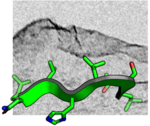
June 2022 - Paper in Langmuir
SurfLab researchers, together with an international team of collaborators, have published a paper in Langmuir entitled “Peptide Mimic of the Marine Sponge Protein Silicatein Fabricates Ultrathin Nanosheets of Silicon Dioxide and Titanium Dioxide”.
The paper uses a range of surface specific techniques to explore the formation of nanometer thin and stable sheets of silicon dioxide and titanium dioxide catalyzed by a marine sponge mimicking peptide.
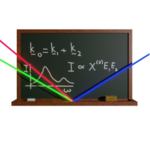
February 2022 - Article series - Biointerfaces
James Pickering and SurfLab researchers publishes an article series “Tutorials in Vibrational Sum Frequency Generation Spectroscopy” in special topic collection of Biointerfaces.
The three papers take you through the fundamentals of SFG, building your first SFG setup and data treatment/analysis with accessible explanations targeted at people without strong formal backgrounds in mathematics or physics.
Tutorials in Vibrational Sum Frequency Generation Spectroscopy I: The Foundations
Tutorials in Vibrational Sum Frequency Generation Spectroscopy III: Collecting, Processing, and Analysing VSFG Spectra

December 2021 - Article in Biomacromolecules
Surflab researchers, together with collaborators from the Department of Molecular Biology and Genetics at Aarhus University, have published an article in Biomacromolecules entitled "Electrostatics Trigger Interfacial Self-Assembly of Bacterial Ice Nucleators".
Link to the article: https://doi.org/10.1021/acs.biomac.1c01217
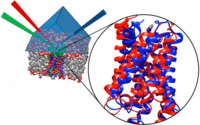
November 2021
Surflab researchers and a team of collaborators have published an article in Langmuir entitled "Membrane Structure of Aquaporin Observed with Combined Experimental and Theoretical Sum Frequency Generation Spectroscopy".
The work highlights the protein structure sensitivity of SFG spectroscopy.
Link: https://pubs.acs.org/doi/full/10.1021/acs.langmuir.1c02206
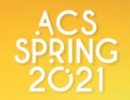
April 2021
Mette H. Rasmussen’s talk about the surface chemistry of snake slithering at the ACS Spring Meeting 2021 has been highlighted by the organizers. Mette's talk has led to articles in several news outlets, including:
March 2021
A short book about optics and lasers has been published through IOP ebooks by postdoc James Pickering.
Title: Ultrafast Lasers and Optics for Experimentalists
Working with ultrashort femtosecond laser pulses requires some special care when compared to other laser systems, and the book provides an ideal starting point for the non-specialist to gain the necessary knowledge to start effectively working with ultrafast lasers and optics.
March 2021
Surflab researchers, together with an international team of collaborators, have published a paper in Nature Communications entitled "Ice Nucleating Proteins Are Activated by Low Temperatures to Control the Structure of Interfacial Water".
Paper in Nature Communications
The article was highlighted by the editor as a Feature Article.
February 2021
Jan Thøgersen publishes an article entitled "The primary photo-dynamics of lactate in aqueous solution: decarboxylation prevents dehydroxylation" in Physical Chemistry Chemical Physics.
The work has been a collaboration with Frank Jensen and Veronica Vaida.
January 2021
A new article on dysferlin has been published in the Journal of Physical Chemistry B by SurfLab researchers in collaboration with researchers from the Oregon State University:
Direct Evidence That Mutations within Dysferlin’s C2A Domain Inhibit Lipid Clustering
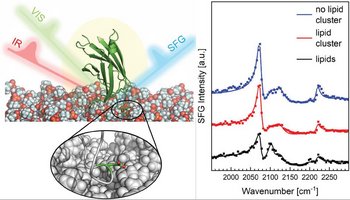
September 2020 - Article in Langmuir
Surflab researchers with collaborators from the University of Washington, Seattle, have published an article in Langmuir.
The study highlights news methods to determine protein structure at interfaces:
Orientation and Conformation of Proteins at the Air-Water Interface Determined from Integrative Molecular Dynamics Simulations and Sum Frequency Generation Spectroscopy
Thaddeus Golbek and Tobias Weidner have a joint paper with researchers from China and Germany in Nano Letters about ageing of 2D materials:
Previous studies indicate that 2D materials such as graphene, WS2 and MoS2 deposited on oxidized silicon substrate are susceptible to aging due to the adsorption of airborne contamination. As a result, their surfaces become more hydrophobic. However, it is not clear how ubiquitous such a hydrophobisation is, and the interplay between the specific adsorbed species and resultant wetting aging ...
March 2020
Thaddeus Golbek together with SurfLab researchers and Thomas Poulsen publish a paper in Langmuir entitled: Lasalocid Acid Antibiotic at a Membrane Surface Probed by Sum Frequency Generation Spectroscopy
February 2020
Steven Roeters and Tobias Weidner publish an article in Chemical Reviews: "Structure and Dynamics of Interfacial Peptides and Proteins from Vibrational Sum-Frequency Generation Spectroscopy"
February 2020
Lars Schmüser and Tobias Weidner, together with scientists from Germany and the United States, publish an article in ACS Applied Materials and Interfaces: "The role of surface chemistry for the super-hydrophobicity of the springtail Orchesella cincta (Insecta:Collembola)"
October 2019
Article published in Nature Communications by Mette Rasmussen and Tobias Weidner:
"NEXAFS imaging to characterize the physio-chemical composition of cuticle from African Flower Scarab Eudicella gralli"
September 2019
Thaddeus Golbek, Steven Roeters and Tobias Weidner publish a paper in Biophysical Journal jointly with researchers at Oregon State University entitled "Otoferlin C2F Domain-Induced Changes in Membrane Structure Observed by Sum Frequency Generation".